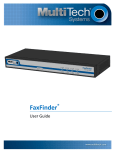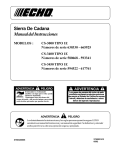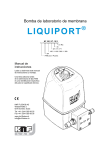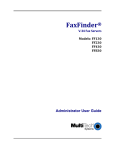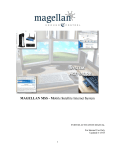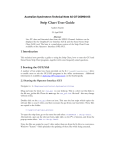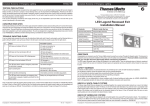Download Emerson USB Fieldbus Interface User`s manual
Transcript
User's Manual AW7060MNL, Rev 2 May 2014 USB Fieldbus Interface User's Manual User's Manual May 2014 Copyright © Emerson Process Management, 2014. All rights reserved. Printed in the USA. Trademarks The Emerson logo is a trademark and service mark of Emerson Electric Co. AMS is a mark of one of the Emerson group of companies. FOUNDATION™ is a mark of the Fieldbus Foundation of Austin, Texas, USA. Microsoft and Windows are registered trademarks of the Microsoft Corporation in the United States and/or other countries. PACTware is a trademark of PACTware Consortium e.V. All other marks are property of their respective owners. Contents Introduction ................................................. 3 Approvals and certifications ........................47 USB Fieldbus Interface .................................. 5 Specifications ............................................. 48 Software installation and device setup ........10 Waste disposal ............................................49 Fieldbus Interface Configuration utility .......................................................... 16 Install drivers manually ............................... 50 Using with AMS Device Manager .................24 Using with an FDT Frame Application ..........32 Troubleshooting ......................................... 43 2 Disable driver signature enforcement in Windows 8.0 and 8.1 .................................. 54 Remove pre-release driver versions on a Windows XP operating system ....................55 May 2014 1 User's Manual Introduction This manual guides you in using the USB Fieldbus Interface (interface) to power and/or configure fieldbus devices. Included here are basic setup, configuration, and troubleshooting information, as well as guidelines on how to use the interface with AMS Suite: Intelligent Device Manager and with a third-party FDT Frame Application. This manual is divided into the following sections: • Chapter 1: Introduction – contains safety messages and information about this manual. • Chapter 2: USB Fieldbus Interface – contains information about the interface, its parts, usage, and features. • Chapter 3: Software installation and device setup – contains system requirements, software installation instructions, and device setup information. • Chapter 4: Fieldbus Interface Configuration utility – contains information on how to use the utility to power, commission, and/or configure some parameters of fieldbus devices. • Chapter 5: Using with AMS Device Manager – contains setup information and instructions in using the interface with AMS Device Manager to configure fieldbus devices. • Chapter 6: Using with an FDT Frame Application – contains setup information and instructions in using the interface with an FDT Frame Application to configure fieldbus devices. • Chapter 7: Troubleshooting – contains solutions to the most common operating problems. • Appendix A: Approvals and certifications – contains certifications and approval information. • Appendix B: Specifications – contains specifications such as operating temperature, software, electrical information, and environmental considerations. • Appendix C: Waste disposal – contains the interface disposal guidelines. • Appendix D: Install drivers manually – contains instructions on how to install drivers manually should they fail to install automatically for Windows XP operating systems. • Appendix E: Disable driver signature enforcement in Windows 8.0 and 8.1 – contains information on how to disable driver signature enforcement on Windows 8.0 and 8.1 operating systems. • Appendix F: Remove pre-release driver versions on a Windows XP operating system – contains instructions on how to remove previous driver versions. 3 User's Manual 1.1 May 2014 Safety message WARNING! Do not connect the USB Fieldbus Interface to a live segment (with an active DCS Host and power supply attached) if the power indicator light on the interface is amber in color. Doing so can disrupt communications and may compromise automation safety. 4 May 2014 2 User's Manual USB Fieldbus Interface Topics covered in this chapter: • Overview • Parts and function • Power modes 2.1 Overview The USB Fieldbus Interface enables two-way communication between a computer and fieldbus devices. Its primary function is to allow the setup, configuration, monitoring, and troubleshooting of fieldbus devices through a computer. The interface is fully compatible with all FOUNDATION fieldbus (FF) devices and is always configured as a "visitor." Features Compliant with USB 1.1 and USB 2.0 specifications Works with standard USB cables Can detect a Link Active Scheduler (LAS) and will take over as a LAS if it is not present on the segment Can be connected to any fieldbus segment containing a FOUNDATION fieldbus device Has software support for both Device Descriptors (DDs) and FDT Device Type Managers (DTMs) It is particularly useful in these plant scenarios: • Workbench setup and troubleshooting of fieldbus devices • With a laptop in the field to configure, commission, decommission, or troubleshoot fieldbus devices 5 User's Manual May 2014 The USB Fieldbus Interface comes with a USB cable, lead set, user's manual*, and installation CD*. Figure 2-1: Box contents 6 May 2014 2.2 User's Manual Parts and function Figure 2-2: USB Fieldbus Interface 1 Field connection indicator light (*) Indicates the fieldbus device connection status 2 Power indicator light (*) Indicates the power mode of the interface 3 USB port Enables USB connection 4 Fieldbus device connection socket Enables fieldbus device or segment connection (*) See the Indicator light scenarios table. 7 User's Manual May 2014 Table 2-1: Indicator light scenarios Power indicator light Field connection indicator light Scenarios Normal scenarios Green Green The USB Fieldbus Interface is connected to an externally powered segment and is able to communicate. Amber Green The USB Fieldbus Interface is providing power to a fieldbus segment and is able to communicate. Off The USB Fieldbus Interface is not connected to a powered computer. -ORThe USB Fieldbus Interface is connected to a computer but the computer power is off. -ORThe USB FF HSE Server is not running on the connected computer. Green Off The USB Fieldbus Interface is not connected to a powered segment. -ORThe USB Fieldbus Interface is connected to a powered segment with the wrong polarity. Off Green Amber Red The USB Fieldbus Interface is providing power but a short circuit has been detected on the field connection. Amber Off The USB Fieldbus Interface is providing power and connected to an already powered fieldbus segment with reverse polarity. Amber Amber Other scenarios Off 8 The USB Fieldbus Interface is connected normally to a powered segment but the USB FF HSE Server is not running. The USB Fieldbus Interface is providing power to a fieldbus segment and the load on that segment has exceeded its limit. May 2014 2.3 User's Manual Power modes The USB Fieldbus Interface is capable of working in two power modes: • Mode 1 - The interface does not supply power to the connected fieldbus device or segment. The fieldbus device or segment is powered by an external source. Mode 1 is the default. • Mode 2 - The interface powers the connected fieldbus device or segment and no external power is needed. The interface is capable of powering multiple devices on a fieldbus segment through an external USB hub. It can provide current of up to 85 mA (typically sufficient for three or four fieldbus devices on the same segment). You can configure Mode 2 using the Fieldbus Interface Configuration utility. For more information, see Section 4.2. WARNING! Choose only one power mode. Never attempt to use two power sources at the same time. Doing so can disrupt communications and may compromise automation safety. 9 User's Manual 3 May 2014 Software installation and device setup Topics covered in this chapter: • System requirements • Install the Fieldbus Interface Configuration utility • Install the Communication DTM software • Install the Emerson DTM Library • Setup and connection • Connect to a live fieldbus segment Perform software installation and device setup in the following order: 1. Install the Fieldbus Interface Configuration utility. This allows you to configure the USB Fieldbus Interface and connected fieldbus devices. 2. Install the Communication DTM software. This enables DTM support for connected fieldbus devices. 3. Install the Emerson DTM Library. This allows you to use DTMs associated with Emerson devices through an FDT Frame Application. Note Device DTMs are usually acquired from device suppliers. Contact your device supplier if you have a non-Emerson device and install the appropriate third-party DTM library. 4. Set up and configure connected fieldbus devices. 3.1 System requirements Supported operating systems Windows 8.0 and 8.1 Windows 7 (32- or 64-bit) Windows XP Home or Professional (32-bit) SP3 Hard disk space At least 500MB Hardware USB 1.1 or USB 2.0 port 10 May 2014 3.2 User's Manual Install the Fieldbus Interface Configuration utility Notes • Do not connect the USB Fieldbus Interface to the computer or to a fieldbus device or segment until software installation is complete. • You may be prompted to determine the operating system and the Windows version (32-bit or 64-bit) running on your computer. Keep this information handy. • You may not be able to install drivers that are not signed by Microsoft on some Windows 8.0 and 8.1 operating systems. To override this requirement, see Appendix E. 1. Insert the USB Fieldbus Interface installation CD into the CD drive of your computer. Software and driver installation should start automatically. If AutoRun is not enabled, double-click setup.exe. Should driver installation fail to start automatically, you will be prompted to install it manually. Follow the procedure in Appendix D. 2. Follow the prompts on the installation window. Figure 3-1: Fieldbus Interface Configuration utility installation 3. Click Finish when done. 11 User's Manual 3.3 May 2014 Install the Communication DTM software 1. Insert the USB Fieldbus Interface installation CD into the CD drive of your computer. 2. Navigate to the Emerson USB Fieldbus Interface DTM folder and doubleclick Setup.exe. 3. Click Next and follow the prompts on the installation window. Figure 3-2: Communication DTM installation 4. Click Finish when done. 3.4 Install the Emerson DTM Library 1. Insert the USB Fieldbus Interface installation CD into the CD drive of your computer. 2. Navigate to the Emerson DTM Library folder. The DTM library folder is typically named "Emerson Process Management FF Device DTM Library v1.x.x". 3. Double-click Setup > Setup.exe. 4. Click Next and follow the prompts on the installation window. 12 May 2014 User's Manual Figure 3-3: Emerson DTM Library installation 5. Click Close when done. 13 User's Manual 3.5 May 2014 Setup and connection Note Install the Fieldbus Interface Configuration utility first before setting up and connecting the USB Fieldbus Interface. For more information, see Section 3.2 1. Connect the USB Fieldbus Interface to the computer using the USB cable provided. Driver installation should start automatically. If automatic driver installation fails, you need to manually install drivers. For instructions, see Appendix D. 2. Connect the interface to a fieldbus device or to a fieldbus segment using the field leads. WARNING! Do not proceed to the next step if you are connecting to a live (powered) segment. Providing additional power source to an already powered segment can disrupt communications and may compromise automation safety. 3. Power the connected fieldbus device or segment. Connect the fieldbus device or the unpowered segment to an external power source (Mode 1), or provide power using the Fieldbus Interface Configuration utility (Mode 2). For more information on the power modes, see Section 2.3. 14 May 2014 User's Manual Figure 3-4: Sample benchtop connection 3.6 Connect to a live fieldbus segment WARNING! Do not use the Provide Power option on the Fieldbus Interface Configuration utility when connecting to a live segment. Doing so can disrupt communications and may compromise automation safety. 1. Make sure the USB Fieldbus Interface is connected to the computer and that all software and drivers are installed. 2. Plug one end of the field lead to the fieldbus device connection socket of the interface and connect the other end to the live fieldbus segment. Notes • The USB Fieldbus Interface draws current of 10 mA from the segment. Make sure the segment has enough power and has the capacity to provide this additional current. • Make sure the lead set is connected to the live fieldbus segment with the correct polarity. • Commissioning, decommissioning, and changing the device tag/address are not allowed for fieldbus devices connected to a live segment. 15 User's Manual 4 May 2014 Fieldbus Interface Configuration utility Topics covered in this chapter: • Launch the Fieldbus Interface Configuration utility • Power fieldbus devices • Commission fieldbus devices • Decommission fieldbus devices • Change the device class • Start or stop the USB FF HSE Server manually 4.1 Launch the Fieldbus Interface Configuration utility • Click Start > All Programs > Emerson Process Management > USB Fieldbus Interface > USB Fieldbus Interface. or • Double-click the USB Fieldbus Interface desktop shortcut. This is only available when you have selected the desktop icon option during software installation. Note If no fieldbus device is detected after 30 seconds, this dialog is displayed. Click OK to continue. Figure 4-1: No device detected dialog A connected fieldbus device or segment has to be powered by an external power source or be provided power by the Fieldbus Interface Configuration utility for it to be detected. For more information, see Section 7.2. 16 May 2014 4.2 User's Manual Power fieldbus devices You can power a fieldbus device or segment by connecting it to an external power source or by using the Fieldbus Interface Configuration utility. The following steps detail how to use the Fieldbus Interface Configuration utility to power fieldbus devices. 1. Launch the Fieldbus Interface Configuration utility. 2. Click the USB Fieldbus Interface icon in the tree view. 3. Select the Provide Power check box. Note The USB Fieldbus Interface is only capable of providing an output current of up to 85 mA. Typically, you should not attempt to connect more than three or four fieldbus devices on the same segment when using the Provide Power option. Figure 4-2: Provide Power option WARNING! Do not use the Provide Power option on a live (already powered) segment. Doing so can disrupt communications and may compromise automation safety. 4. Click OK to acknowledge the warning. 5. Click Apply. 6. Select Yes to restart the USB FF HSE Server and use the new setting. 17 User's Manual 4.3 May 2014 Commission fieldbus devices Commissioning sets the fieldbus device address to a valid permanent address and sets the device tag to a valid string. Notes • You need to commission fieldbus devices first before you can use them with AMS Device Manager or with an FDT Frame Application. • Fieldbus devices on a live segment cannot be commissioned. 1. Launch the Fieldbus Interface Configuration utility. 2. Under the USB Fieldbus Interface icon, select the fieldbus device you want to configure. Note A connected fieldbus device or segment should be powered by an external power source or be provided power by the Fieldbus Interface Configuration utility for it to be detected. 3. Optionally, select a permanent device address from 20 to 38. Otherwise, the first available address is assigned. Note The utility only accepts device addresses in the range of 20 through 38. 4. Optionally, enter a device tag. 5. Click Commission. 18 May 2014 User's Manual Figure 4-3: Commission Note The commissioning process takes about 1 to 2 minutes to complete. 6. Repeat steps 2 through 5 for each device you want to commission. 4.4 Decommission fieldbus devices Decommissioning sets the fieldbus device address to a temporary address. Note Fieldbus devices on a live segment cannot be decommissioned. 1. Launch the Fieldbus Interface Configuration utility. 2. Under the USB Fieldbus Interface icon, select the fieldbus device you want to configure. Note A connected fieldbus device or segment should be powered by an external power source or be provided power by the Fieldbus Interface Configuration utility for it to be detected. 3. Click Decommission. 19 User's Manual May 2014 Figure 4-4: Decommission 4. Determine if the fieldbus device was commissioned on another host, then select Yes or No. • If you choose Yes, the decommissioning proceeds. • If you choose No, you cannot decommission the device. Decommissioning is not allowed for devices commissioned on another host. 5. Repeat steps 2 through 4 for each device you want to decommission. 4.5 Change the device class A connected fieldbus device can be assigned as a Link Master (LM) or as a basic device. A Link Master contains the LAS functionality that controls communications on a fieldbus link or segment. 1. Launch the Fieldbus Interface Configuration utility. 2. Under the USB Fieldbus Interface icon, select the fieldbus device you want to configure. Note A connected fieldbus device or segment should be powered by an external power source or be provided power by the Fieldbus Interface Configuration utility for it to be detected. 3. From the Device Class section, click Read to identify if the fieldbus device is a Link Master or a basic device. 20 May 2014 User's Manual Note Only the device class of a commissioned fieldbus device can be identified. For more information on commissioning a device, see Section 4.3. Figure 4-5: Identify the device class 4. Switch to Basic or Link Master from the drop-down menu and click Apply. 21 User's Manual May 2014 Figure 4-6: Change the device class 5. Click Yes to acknowledge the restart of the device. 6. Click OK to continue. Note Changing the device class takes about 1 minute to complete. 4.6 Start or stop the USB FF HSE Server manually The USB FF HSE Server automatically starts when you launch the Fieldbus Interface Configuration utility. It is typically not necessary to start or stop the USB FF HSE Server manually. 1. Launch the Fieldbus Interface Configuration utility. 2. Click the USB FF HSE Server icon in the tree view. 3. Click Start Server or Stop Server. 22 May 2014 User's Manual Figure 4-7: Start Server/Stop Server Note The USB FF HSE Server should be running in order to use the Fieldbus Interface Configuration utility to power or configure a fieldbus device or segment. 23 User's Manual 5 May 2014 Using with AMS Device Manager Topics covered in this chapter: • Add a network component in AMS Device Manager • Configure fieldbus devices in AMS Device Manager AMS Device Manager provides a single application for predictive diagnostics, documentation, calibration management, and device configuration. Using AMS Device Manager gives you better visibility into the assets in your plant, resulting in faster startup and increased availability through more costeffective maintenance and improved asset performance. Contact your Emerson Sales/Support representative for more information on AMS Device Manager. 5.1 Add a network component in AMS Device Manager An FF HSE network component has to be present in order to use the USB Fieldbus Interface with AMS Device Manager. Notes • If there is an existing FF HSE network configured for another fieldbus device, you do not need to add a new FF HSE network component. • You must have an updated license file that includes an HSE license. The HSE license enables you to add an FF HSE network component in AMS Device Manager. If you do not yet have an HSE license, contact your Emerson sales representative and place an order for part number AW7060HSE. 1. Click Start > All Programs > AMS Device Manager > Network Configuration to open the AMS Device Manager Network Configuration utility. 2. Click Add. 24 May 2014 User's Manual Figure 5-1: Add a network component 3. Select the FF HSE Network component, and click Install. 25 User's Manual May 2014 Figure 5-2: Install an FF HSE network component 4. Click Next to proceed. 5. Enter a name for the FF HSE network, and click Next. 26 May 2014 User's Manual Figure 5-3: Enter a network name 6. Choose to automatically discover FF HSE linking devices or manually configure IP addresses for FF HSE linking devices. 27 User's Manual May 2014 Figure 5-4: Configure the network connection Notes • Choosing the PC NIC address in the Primary HSE NIC Address field displays the USB Fieldbus Interface and any local FF HSE interfaces on the network in the AMS Device Manager hierarchy. • Choosing the localhost address (127.0.0.1) in the Primary HSE NIC Address field displays only the USB Fieldbus Interface in the AMS Device Manager hierarchy. • Manually entering IP addresses displays manually entered FF HSE networks and the USB Fieldbus Interface in the AMS Device Manager hierarchy. • The USB Fieldbus Interface does not support FF device alerts. 28 May 2014 User's Manual 7. Click Finish when done. 5.2 Configure fieldbus devices in AMS Device Manager Note Commission fieldbus devices first in the Fieldbus Interface Configuration utility before configuring them in AMS Device Manager. For more information, see Section 4.3. 1. Click Start > All Programs > AMS Device Manager > AMS Device Manager to open AMS Device Manager. 2. Enter your username and password, and click OK. 3. From the Device Connection or Device Explorer view, right-click the FF HSE network icon and select Rebuild Hierarchy. The USB Fieldbus Interface icon then appears under the FF HSE network. Figure 5-5: USB Fieldbus Interface icon in AMS Device Manager 4. If you are using the Device Connection View, click the sign next to the USB Fieldbus Interface icon to display a list of connected fieldbus devices. 5. If necessary, right-click the USB Fieldbus Interface icon and then scan new devices. 29 User's Manual May 2014 Scanning synchronizes the AMS Device Manager database with connected live devices. 6. Right-click the fieldbus device you want to configure and select from the context menus. Figure 5-6: Fieldbus device context menus 30 Configure Displays configuration parameters that define the physical attributes and operating characteristics of the device. Compare Lets you compare two configurations of the device. Service Tools or Device Diagnostics Displays alert conditions. These include hardware and software malfunctions or parameters with values beyond the device specifications. Overview or Process Variables Displays the current output from the device. May 2014 User's Manual For more information about the context menus and other AMS Device Manager functions, refer to AMS Device Manager Books Online. 31 User's Manual 6 May 2014 Using with an FDT Frame Application Topics covered in this chapter: • Install an FDT Frame Application • Update the DTM library • Configure fieldbus devices in an FDT Frame Application You can also configure fieldbus devices using third-party FDT Frame Applications. For the purpose of this document, PACTware is used as an example. PACTware can be downloaded from multiple sites on the Internet. 6.1 Install an FDT Frame Application Note Install the Communication DTM software and the Emerson DTM Library first before installing an FDT Frame application. For instructions, see Section 3.3 and Section 3.4. To be able to view DTMs associated with a device, an FDT Frame Application should be installed. Follow the manufacturer's recommended software installation instructions. For the purpose of this document, PACTware is used. 6.2 Update the DTM library Note You only need to update the DTM library when a new DTM is recently added. 1. Launch PACTware. 2. Press F3 to show the Device catalog and click Update device catalog. 32 May 2014 User's Manual Figure 6-1: Update device catalog 3. Click Yes when prompted to create a new PACTware device catalog. 4. Close the device catalog when done. 6.3 Configure fieldbus devices in an FDT Frame Application Notes • Install the Communication DTM software and the DTM Library first before configuring fieldbus devices in an FDT Frame Application. For more information, see Section 3.3 and Section 3.4. • If necessary, update the DTM library. For more information, see Section 6.2. • Make sure the USB Fieldbus Interface and fieldbus devices are correctly set up and that the Fieldbus Interface Configuration utility is installed and running. For more information, see Section 3.5 and Chapter 4. 1. Launch PACTware. 2. From the Project pane, right-click HOST PC and click Add device. 33 User's Manual May 2014 Figure 6-2: Project pane Press F2 to display the Project pane if it is not already displayed. 3. Select Emerson FF HSE Server and click OK. Figure 6-3: Add the Emerson FF HSE Server 4. Right-click FF HSE Server on the Project pane and click Add device. 34 May 2014 User's Manual Figure 6-4: FF HSE Server - Add device 5. Select Emerson USB Fieldbus Interface and click OK. 35 User's Manual May 2014 Figure 6-5: Add the Emerson USB Fieldbus Interface 6. Right-click USB Fieldbus Interface on the Project pane and click Add device. 36 May 2014 User's Manual Figure 6-6: USB Fieldbus Interface - Add device 7. Select the device you want to add then click OK. 37 User's Manual May 2014 Figure 6-7: Add device Only devices with DTMs available and installed appear on the list. For more information on DTM library installation, see Section 3.4. Repeat steps 6 and 7 if you want to add more devices to the list. 8. Right-click USB Fieldbus Interface and select Additional functions > Edit DTM Address. 38 May 2014 User's Manual Figure 6-8: Edit DTM Address 9. On the right pane, select the fieldbus device from the list, enter the device address in the Node ID field, and click Apply. Figure 6-9: Enter Node ID 39 User's Manual May 2014 Note The device address and Node ID should match. The device address is set and can be found in the Fieldbus Interface Configuration utility. For more information on setting the device address, see Section 4.3. 10. Right-click HOST PC and click Connect. Figure 6-10: Connect devices This connects all devices under the host PC. You can also opt to select each device you want connected and click Connect. Connected devices appear in bold face type in the menu tree. 11. Right-click the fieldbus device you want to configure and click Parameter. 40 May 2014 User's Manual Figure 6-11: Parameter This displays the various parameters you can edit for the device. 12. Configure the parameters of the device. Note The parameter display varies and is dependent on the device manufacturer. 41 User's Manual May 2014 Figure 6-12: Edit device parameters 42 May 2014 7 User's Manual Troubleshooting Topics covered in this chapter: • Fieldbus device not responding in AMS Device Manager • Fieldbus device not detected in Fieldbus Interface Configuration utility • Cannot edit device parameters in FDT Frame Application 7.1 Fieldbus device not responding in AMS Device Manager In order to configure a fieldbus device in AMS Device Manager, you must first commission the device in the Fieldbus Interface Configuration utility. For more information on commissioning a device, see Section 4.3. Uncommissioned devices are seen in AMS Device Manager as having the (non-responding device) icon and are characterized by an empty device tag or by the device default address. Figure 7-1: Uncommissioned device in AMS Device Manager 43 User's Manual May 2014 Commissioned fieldbus devices appear with their own icons in AMS Device Manager and are characterized by a valid permanent address or by a valid device string. Figure 7-2: Commissioned device in AMS Device Manager 7.2 Fieldbus device not detected in Fieldbus Interface Configuration utility The Fieldbus Interface Configuration utility immediately detects connected fieldbus devices. If 30 seconds have elapsed and no device is detected, the following dialog is displayed. 44 May 2014 User's Manual Figure 7-3: No device detected dialog Click OK and check for the following: • Make sure the fieldbus device or segment is powered either by an external source or by the USB Fieldbus Interface. For more information, see Section 2.3. • Make sure drivers are installed and that the hardware is ready for use. If automatic driver installation fails, install drivers manually. For more information, see Appendix D. • Check that there are no loose connections and that the USB cable does not exceed 2 meters in length. • Make sure the USB FF HSE Server is running. 45 User's Manual 7.3 May 2014 Cannot edit device parameters in FDT Frame Application Figure 7-4: Cannot edit device parameters in PACTware • Check the Node ID in PACTware and the Device Address in the Fieldbus Interface Configuration utility. The Node ID and Device Address should match. You may need to manually enter the Node ID in PACTware. For more information on entering the Node ID, see Section 6.3. • Update the DTM library. If a new DTM is added, you may need to update the DTM library. For more information, see Section 6.2. • Check physical connections. Make sure all devices are properly connected and have access to a power source. For more information, see Section 3.5. • Commission the fieldbus device. For more information, see Section 4.3. 46 May 2014 User's Manual Appendix A Approvals and certifications Fieldbus Foundation Communication FF Physical Layer Specification (IEC 61158-2) FF Physical Layer Conformance Test (FF830) CE EN 61326-1-2006, Radiated Emissions Class B, Basic Immunity Test Requirements. ETL (US and Canada) Conforms to ANSI/UL STD 60950-1; Certified to CAN/CSA STD C22.2 NO. 60950-1. IC This Class B digital apparatus complies with Canadian ICES-003, Issue 4:2004. Cet appareil numérique de la classe B est conforme à la norme NMB-003 du Canada. FCC This device complies with Part 15 Subpart B of the FCC Rules. Operation is subject to the following conditions: 47 CFR, Part 15:2009, §15.107, §15.109, Class B Any modifications made to this device that are not approved by Emerson Process Management may void the authority granted to the user by the FCC to operate this equipment. 47 User's Manual May 2014 Appendix B Specifications Software Supported operating systems Windows 8.0 and 8.1 Windows 7 (32- or 64-bit) Windows XP Home or Professional (32-bit) SP3 USB 1.1 and USB 2.0 interface Drivers included Application software AMS Device Manager Version 11.5 or later License AMS Device Manager HSE license Part number AW7060HSE Electrical Power consumption (Mode 1) ≤ 0.2 W Power consumption (Mode 2) at 85 mA output current ≤ 2.5 W at 50 mA output current ≤ 1.7 W Power supply to a fieldbus segment (in Mode 2) 85 mA at 10V Environmental 48 Operating temperature -20 °C to 60 °C (-4 °F to 140 °F) Storage temperature -40 °C to 85 °C (-40 °F to 185 °F) Storage humidity 0 to 95% relative humidity May 2014 User's Manual Appendix C Waste disposal Products with the following label comply with the Waste Electrical and Electronic Equipment (WEEE) directive, 2002/96/EC, which applies to European Union (EU) member states only. The label indicates this product should be recycled and not treated as household waste. Customers in EU member states should contact their Emerson sales representative for information on discarding any part of the USB Fieldbus Interface. For customers in all other world areas, if it is necessary to discard any part of the USB Fieldbus Interface, follow the waste disposal regulations applicable in your location. 49 User's Manual May 2014 Appendix D Install drivers manually Notes • If you have previously installed a pre-release version of drivers, follow the procedure in Appendix F first before installing new drivers manually. • The following procedure only applies to Windows XP operating systems. On Windows 7 operating systems, drivers are automatically installed. • There are two drivers that have to be installed manually; one for ports and another for USB controllers. You need to complete the driver installation on the Found New Hardware Wizard twice to install both drivers. 1. Connect the USB Fieldbus Interface to the computer using the USB cable provided. This facilitates manual installation of drivers through the Found New Hardware Wizard. 2. From the Found New Hardware Wizard, select the No, not this time option and click Next. 3. Select the Install from a list or specific location (Advanced) option and click Next. 4. Select the Search for the best driver in these locations option and select the Include this location in the search check box. 50 May 2014 User's Manual Figure D-1: Found New Hardware Wizard - Select driver location 5. Browse to where the drivers are located and click Next. The drivers are typically in C:\Program Files\Emerson Process Management\USB Fieldbus Interface \Drivers. 6. If a Windows Logo compatibility warning is displayed, click Continue Anyway to continue the driver installation. The wizard installs the driver. 7. Click Finish to close the wizard and start the second driver installation. After closing, the Found New Hardware Wizard opens again to install the second driver. 8. Repeat steps 2 through 7 to complete the second driver installation. Note For the second driver installation, you may be prompted to select the driver that best matches the connected USB Fieldbus Interface. This happens when you have previously installed a prerelease version of the driver. Always select the second entry on the dialog, then click Next. 51 User's Manual May 2014 Figure D-2: Found New Hardware Wizard - Select best driver match If you want to verify the proper installation of drivers, open Windows Device Manager and check that drivers are installed under Ports (COM & LPT) and Universal Serial Bus controllers sections. 52 May 2014 User's Manual Figure D-3: Windows Device Manager 53 User's Manual May 2014 Appendix E Disable driver signature enforcement in Windows 8.0 and 8.1 1. Open the Windows 8 Charms bar. 2. Click Settings > Change PC settings. 3. From the PC Settings window, select General on the left panel. 4. On the right panel, locate Advanced startup and select Restart now. 5. From the Choose an option menu, select Troubleshoot. 6. From the Troubleshoot menu, select Advanced options. 7. From the Advanced options menu, select Startup Settings. 8. Click Restart and select Disable driver signature enforcement. 54 May 2014 User's Manual Appendix F Remove pre-release driver versions on a Windows XP operating system 1. Click Start > Control Panel > Add or Remove Programs. 2. Select 770 USB Serial Converter Drivers from the list, and then click Change/ Remove. If 770 USB Serial Converter Drivers is not on the list, proceed to Step 4. 3. Follow the prompts on the uninstallation window, then click Finish. 4. If necessary, uninstall the drivers using Windows Device Manager: a. Launch Windows Device Manager (Start > Run, type devmgmt.msc, and click OK). b. Expand Ports (COM & LPT). c. Connect the USB Fieldbus Interface to the computer through the USB port and wait a few seconds to see if 770 Fieldbus Interface (COMxx) appears on the list. If it does not, proceed to Step 5. d. Right-click 770 Fieldbus Interface (COMxx), and select Uninstall. e. Click OK to confirm the driver removal. f. Expand Universal Serial Bus controllers, right-click 770 Fieldbus Interface, and select Uninstall. g. Click OK to confirm the driver removal. 5. After removing previous driver versions, install current drivers manually. Follow the procedure in Appendix D. 6. After installing current drivers, open Windows Device Manager. 7. Expand Ports (COM & LPT), right-click 770 Fieldbus Interface (COMxx), and select Properties. 8. From the Port Settings tab, select Advanced. 9. From the BM Options section, set the Latency Timer value to 1 and click OK. 55 User's Manual May 2014 Figure F-1: Advanced Settings for COMxx dialog 10. Click OK to close the Properties dialog. 56 May 2014 User's Manual Index A not responding in AMS Device Manager, troubleshooting 43 AMS Device Manager providing power 17 adding network component 24 setting device address 18 using to configure fieldbus devices 29 setting device tag 18 setup and connection 14 C setup and connection, live segment 15 change the device class 20 Fieldbus Interface Configuration utility commission fieldbus devices 18 installing 11 Communication DTM installation 12 launching 16 configure fieldbus devices starting/stopping HSE server manually 22 using AMS Device Manager 29 using PACTware 33 connect to live fieldbus segment 15 contents of box 5 H hard disk space requirement 10 I D decommission fieldbus devices 19 device class, changing 20 drivers automatic installation 11 disable signature enforcement, Windows 8 54 installing manually 50 indicator light status 7 install Communication DTM 12 install drivers manually 50 install Emerson DTM Library 12 install FDT Frame Application 32 install Fieldbus Interface Configuration utility 11 DTM library, installation 12 L F launch the utility 16 features 5 FF HSE network component adding 24 Link Active Scheduler (LAS) 20 Link Master 20 live segment connection 15 field connection indicator light status 7 fieldbus device basic device 20 cannot edit device parameters 46 changing device class 20 commissioning 18 O operating systems, supported 10 overview 5 configuring, using AMS Device Manager 29 P configuring, using PACTware 33 PACTware decommissioning 19 Link Master 20 update device catalog 32 usage 33 live segment connection and setup 15 PACTware usage 33 not detected in utility, troubleshooting 44 parts and function 7 57 User's Manual power indicator light status 7 power modes 9 Provide Power 17 May 2014 T troubleshooting cannot edit device parameters, PACTware 46 fieldbus device not detected in utility 44 R fieldbus device not responding in AMS Device Manager 43 remove pre-release driver versions 55 U S setup and connection benchtop/segment connection 14 live segment connection 15 system requirements 10 58 update device catalog 32 USB FF HSE Server starting, stopping 22 User's Manual Part Number: AW7060MNL, rev. 2 May 2014 Emerson Process Management 12001 Technology Drive Eden Prairie, MN 55344 USA T 1(952)828-3633 F 1(952)828-3006 www.EmersonProcess.com ©2014, Emerson Process Management The contents of this publication are presented for informational purposes only, and while every effort has been made to ensure their accuracy, they are not to be construed as warranties or guarantees, express or implied, regarding the products or services described herein or their use or applicability. All sales are governed by our terms and conditions, which are available on request. We reserve the right to modify or improve the designs or specifications of our products at any time without notice. All rights reserved. The Emerson logo is a trademark and service mark of Emerson Electric Co. All other marks are property of their respective owners. AW7060MNL, printed in USA/05-2014



























































